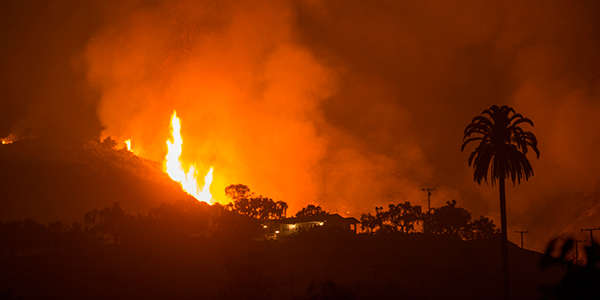By Hudson Sangree
The California Public Utilities Commission late Friday released an administrative law judge’s proposed ruling approving staff’s “stress test” methodology for determining rate recovery for 2017 wildfire costs, part of an effort to maintain the credit ratings of the state’s investor-owned utilities.
The methodology, mandated under last year’s SB 901, seeks to balance the IOUs’ financial health against the impact of rate increases on consumers. (See California Wildfire Bill Goes to Governor.)
The proposed ruling would not apply to Pacific Gas and Electric, however, because it exempts utilities that have filed for Chapter 11 bankruptcy reorganization. PG&E filed for bankruptcy Jan. 29, citing, in part, its liability for a series of 2017 blazes that tore through Northern California wine country and the Sierra Nevada foothills.
The 2018 Camp Fire, the deadliest and most destructive fire in state history, is not covered under the bill’s stress-test provision, though lawmakers may yet apply SB 901’s requirements to 2018 fires and future blazes. State investigators recently blamed the Camp Fire on PG&E equipment. (See Cal Fire Pins Deadly Camp Fire on PG&E.)
The most obvious application of the proposed ruling would be to Southern California Edison. State investigators determined SCE’s power lines sparked the Thomas Fire, a 280,000-acre blaze in Santa Barbara and Ventura counties that killed two people and later caused a mudflow that killed 21. (See Edison Takes Partial Blame for Wildfire in Earnings Call.)
The ALJ’s decision has no legal effect until the CPUC approves it. The commission may consider the ALJ’s proposed order as early as its June 27 meeting.
In the “normal course of regulation of investor-owned utilities, a utility seeks recovery of its anticipated costs of operations and a reasonable return on its investments from ratepayers and seeks equity and debt from public markets to fund those operations in advance of the recovery permitted from ratepayers,” Judge Robert W. Haga wrote.
“In the case of a utility exposed to extraordinary costs as a result of a catastrophic 2017 wildfire, however, Senate Bill 901 … adds an exception to the process of rate regulation of investor-owned utilities. Public Utilities Code Section 451.2(b) enacts a new limitation on recovery of such costs from ratepayers and requires the commission to determine the maximum amount, after assessing the financial status of the electrical corporation … that the corporation can pay without harming ratepayers because of an increased cost for access to capital markets, or materially impacting its ability to provide adequate and safe service from inadequate financial resources.”
The main driver of the stress test “is the implied maximum additional debt that a utility can take on and maintain a minimum investment grade issuer-level credit rating” based on the ratings of Moody’s Corp. and S&P Global, Haga wrote.
Earlier this year, investor services downgraded the credit ratings of PG&E, SCE and Sempra Energy, the parent company of San Diego Gas & Electric, to junk-bond or near-junk status because of wildfire liability worries. California holds utilities strictly liable for fires sparked by their equipment under a state constitutional doctrine known as inverse condemnation. (See Calif. Must Limit Wildfire Liability, Governor Says.)
“The stress test therefore focuses on maintaining an investment grade credit rating because this metric is a predictable indicator of a utility’s ability to access capital markets on reasonable, acceptable terms, which is critical to avoid materially impacting its ability to provide adequate and safe service. … In addition to materially impacting a utility’s ability to provide safe and adequate service, utility ratings below investment grade have negative impacts that harm ratepayers. … The stress-test model therefore looks at the utility’s ability to take on additional debt while maintaining an investment grade credit rating, in order to also minimize financial harm to ratepayers,” Haga wrote.
The proposed decision wouldn’t affect PG&E, he said, because “an electrical corporation that has filed for relief under Chapter 11 of the Bankruptcy Code may not access the stress test to recover costs in an application under Section 451.2(b), because the commission cannot determine the corporation’s ‘financial status,’ which includes, among other considerations, its capital structure, liquidity needs and liabilities, as required by Section 451.2(b), as well as its capacity to take on additional, and all cash or resources that are reasonably available to the utility.”



